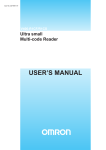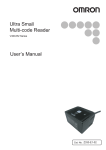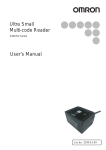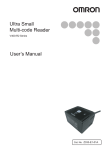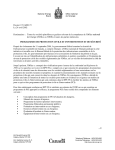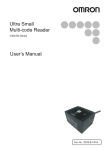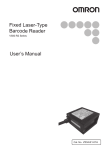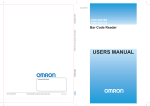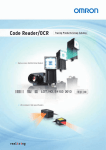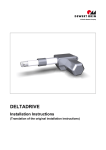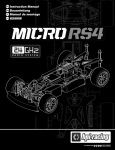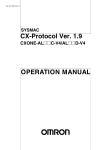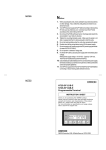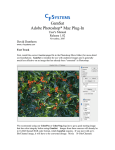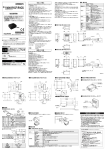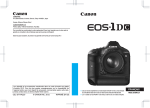Download V400-R1CF/R1CS Multi-code Reaer User`s Manual
Transcript
Ultra small
Multi-code Reader
V400-R1CF/R1CS
User’s Manual
Cat. No. Z276-E1-01A
Introduction
Thank you for purchasing the OMRON V400-R1CF/R1CS.
This manual describes the functions, performance, and application
methods of the V400-R1CF/R1CS.
This manual is intended for personnel with knowledge of electrical
systems. Be sure to read and understand this manual thoroughly before
using the product, and keep this manual in an easily accessible location
for quick reference when required.
Introduction
1 Product Overview
Section
2 Introduction Procedure
Section
3 Basic Knowledge of Operation
Section
4 Setting Method
Section
5 Appendix
Multi-code Reader
User’s Manual
V400-R1CF/R1CS
Section 11 Section
Section 22 Section
Section 33 Section
Section 44 Section 5
Section
Section
Introduction
Introduc-
Introduction READ AND UNDERSTAND THIS DOCUMENT (Be sure to read this.)
Introduction
Introduction
READ AND UNDERSTAND THIS DOCUMENT
Please read and understand this document before using the products. Please consult your OMRON
representative if you have any questions or comments.
WARRANTY
OMRON’s exclusive warranty is that the products are free from defects in materials and workmanship for
a period of one year (or other period if specified) from date of sale by OMRON.
OMRON MAKES NO WARRANTY OR REPRESENTATION, EXPRESS OR IMPLIED, REGARDING
NON-INFRINGEMENT, MERCHANTABILITY, OR FITNESS FOR PARTICULAR PURPOSE OF THE
PRODUCTS. ANY BUYER OR USER ACKNOWLEDGES THAT THE BUYER OR USER ALONE HAS
DETERMINED THAT THE PRODUCTS WILL SUITABLY MEET THE REQUIREMENTS OF THEIR
INTENDED USE. OMRON DISCLAIMS ALL OTHER WARRANTIES, EXPRESS OR IMPLIED.
LIMITATIONS OF LIABILITY
OMRON SHALL NOT BE RESPONSIBLE FOR SPECIAL, INDIRECT, OR CONSEQUENTIAL
DAMAGES, LOSS OF PROFITS OR COMMERCIAL LOSS IN ANY WAY CONNECTED WITH THE
PRODUCTS, WHETHER SUCH CLAIM IS BASED ON CONTRACT, WARRANTY, NEGLIGENCE, OR
STRICT LIABILITY.
In no event shall responsibility of OMRON for any act exceed the individual price of the product on which
liability is asserted.
IN NO EVENT SHALL OMRON BE RESPONSIBLE FOR WARRANTY, REPAIR, OR OTHER CLAIMS
REGARDING THE PRODUCTS UNLESS OMRON’S ANALYSIS CONFIRMS THAT THE PRODUCTS
WERE PROPERLY HANDLED, STORED, INSTALLED, AND MAINTAINED AND NOT SUBJECT TO
CONTAMINATION, ABUSE, MISUSE, OR INAPPROPRIATE MODIFICATION OR REPAIR.
SUITABILITY FOR USE
THE PRODUCTS CONTAINED IN THIS DOCUMENT ARE NOT SAFETY RATED. THEY ARE NOT
DESIGNED OR RATED FOR ENSURING SAFETY OF PERSONS, AND SHOULD NOT BE RELIED
UPON AS A SAFETY COMPONENT OR PROTECTIVE DEVICE FOR SUCH PURPOSES. Please refer
to separate catalogs for OMRON’s safety rated products.
OMRON shall not be responsible for conformity with any standards, codes, or regulations that apply to
the combination of products in the customer’s application or use of the product.
At the customer’s request, OMRON will provide applicable third party certification documents identifying
ratings and limitations of use that apply to the products. This information by itself is not sufficient for a
complete determination of the suitability of the products in combination with the end product, machine,
system, or other application or use.
The following are some examples of applications for which particular attention must be given. This is not
intended to be an exhaustive list of all possible uses of the products, nor is it intended to imply that the
uses listed may be suitable for the products:
• Outdoor use, uses involving potential chemical contamination or electrical interference, or conditions or
uses not described in this document.
2
V400-R1CF/R1CS
User’s Manual
Introduction
Introduction
• Nuclear energy control systems, combustion systems, railroad systems, aviation systems, medical
equipment, amusement machines, vehicles, safety equipment, and installations subject to separate
industry or government regulations.
• Systems, machines, and equipment that could present a risk to life or property.
Please know and observe all prohibitions of use applicable to the products.
NEVER USE THE PRODUCTS FOR AN APPLICATION INVOLVING SERIOUS RISK TO LIFE OR
PROPERTY WITHOUT ENSURING THAT THE SYSTEM AS A WHOLE HAS BEEN DESIGNED TO
ADDRESS THE RISKS, AND THAT THE OMRON PRODUCT IS PROPERLY RATED AND INSTALLED
FOR THE INTENDED USE WITHIN THE OVERALL EQUIPMENT OR SYSTEM.
PERFORMANCE DATA
Performance data given in this document is provided as a guide for the user in determining suitability and
does not constitute a warranty. It may represent the result of OMRON’s test conditions, and the users
must correlate it to actual application requirements. Actual performance is subject to the OMRON
Warranty and Limitations of Liability.
CHANGE IN SPECIFICATIONS
Product specifications and accessories may be changed at any time based on improvements and other
reasons.
It is our practice to change model numbers when published ratings or features are changed, or when
significant construction changes are made. However, some specifications of the product may be
changed without any notice. When in doubt, special model numbers may be assigned to fix or establish
key specifications for your application on your request. Please consult with your OMRON representative
at any time to confirm actual specifications of purchased products.
DIMENSIONS AND WEIGHTS
Dimensions and weights are nominal and are not to be used for manufacturing purposes, even when
tolerances are shown.
ERRORS AND OMISSIONS
The information in this document has been carefully checked and is believed to be accurate; however, no
responsibility is assumed for clerical, typographical, or proofreading errors, or omissions.
PROGRAMMABLE PRODUCTS
OMRON shall not be responsible for the user’s programming of a programmable product, or any
consequence thereof.
COPYRIGHT AND COPY PERMISSION
This document shall not be copied for sales or promotions without permission.
This document is protected by copyright and is intended solely for use in conjunction with the product.
Please notify us before copying or reproducing this document in any manner, for any other purpose. If
copying or transmitting this document to another, please copy or transmit it in its entirety.
V400-R1CF/R1CS
User’s Manual
3
Introduction
Introduction
Safety Precautions
z Meanings of safety symbols
In this operation manual, precautions are indicated using the following symbols and signal words to
ensure safe use of the V400-R1CF/R1CS. The precautions indicated by these symbols and signal words
are important to ensure safety and must be observed.
The symbols and signal words are as follows:
WARNING
Indicates a potentially hazardous situation which, if not avoided, will result in
minor or moderate injury, or may result in serious injury or death. Additionally
there may be significant property damage.
z Meanings of alert symbols
Indicates general prohibitions for which there is no specific symbol.
z Warning display
WARNING
This product is not designed or rated for ensuring safety of persons.
Do not use it for such purposes.
4
V400-R1CF/R1CS
User’s Manual
Introduction
Introduction
Regulations and Standards
This product complies with the following standards.
LED safety standard
IEC 60825-1+A2: 2001 Class 1
JIS C 6802: 2005 Class 1
EC directive
No. 2004/108/EC
EN standard
EN61326
V400-R1CF/R1CS
User’s Manual
5
Introduction
Introduction
Precautions for Safe Use
Observe the following precautions to ensure safe use of the product.
1. Installation Environment
• Do not use the product in environments containing flammable or explosive gases.
• Do not use the product in environments containing corrosive or combustible gases.
• Do not use the product in environments containing dust, salt, or metallic powders.
• Do not use the product in environments containing droplets, water or mist, oil or
chemical agents.
• Do not use the product in environments that may be affected by a CRT's flashing or
other ambient light.
• Do not install or use the product outdoors.
• For the purpose of ensuring safe operation and maintenance, do not install the
product close to high-voltage devices or electrically powered devices.
2. Power Supply and Wiring
• To assure noise and insulation resistance, be sure to use S8VS-01505 (made by
OMRON) as a driving power supply.
• Do not connect a voltage or AC power supply that has a voltage exceeding the rating
voltage (5 V+/-10%).
• Avoid reverse connection of power supply. Do not short circuit a load on OK/NG
output signal (open collector).
• Avoid applying a load that exceeds the rating.
• Be sure to turn the power OFF before connecting or disconnecting a cable.
Connecting or disconnecting a cable while the power is ON may cause failure.
• Connect different cables from high-voltage or power cables to the product. If the
same cable or duct is used, electromagnetic induction may result, which may result in
malfunction or damage.
• Tighten the fixing screws at the torque specified in this manual.
3. Communication with Upper Equipment
• Check that the product has started up, and then start communication with upper
equipment.
• Indefinite signals may be generated from the upper interface while the product starts
up. Clear the receive buffer of the devices before starting initial operation.
6
V400-R1CF/R1CS
User’s Manual
Introduction
• Do not use the product in a safety circuit for nuclear or life-support systems.
• Never attempt to disassemble, repair, modify, deform by applying pressure, or burn
Introduction
4. Other
the product.
• Dispose of the product as industrial waste.
• If the product becomes extremely hot, or abnormal odors or smoke are emitted, stop
using the product immediately, turn the power OFF, and consult with your OMRON
representative.
V400-R1CF/R1CS
User’s Manual
7
Introduction
Introduction
Precautions for Correct Use
Always observe the following precautions to prevent operation failures, malfunctions, and adverse effects
on performance and equipment.
1. Installation location
The product must not be installed in a place:
• where ambient temperature is outside the range defined in the specifications,
• where a rapid temperature change (dew condensation) occurs,
• where ambient humidity is outside the range defined in the specifications,
• where direct vibration or shock may affect the product,
• where exposed to intense ambient light (laser, arc welding, or UV light),
• where exposed to direct sunlight or heat from heating appliances, and
• where a strong magnetic or electric field exists.
Because of the protection rating described in the manual, avoid using
locations containing:
• corrosive or combustible gases,
• dust, salt, or metallic powders,
• droplets, water mist, oil or chemical agents.
2. Power supply, connection, and wiring
• Be sure to use S8VS-01505 (made by OMRON) as a driving power supply.
• Do not install the product in a location where a high-voltage device is installed.
• Be sure to user the supplied insulation board to assure the noise resistance.
• After connecting the cables, check that the correct power supply is used, that there is
no load short-circuiting or other inappropriate connections, and that the load current is
correct before turning the power ON. Faulty wiring may be the cause of failure.
• Use a wrist strap or other similar device to avoid electrostatic charge when you touch
terminals and signal lines within a connector, and to avoid damage due to static
electricity.
• Try to keep the length of the power cable to a minimum (less than 3 m).
3. Labels
• For labels with a highly gloss surface, reading errors may occur because of regular
reflection of the LED light. If this occurs, provide a skew angle of 15° against the
label.
8
V400-R1CF/R1CS
User’s Manual
Introduction
• Install the product so that the front area of the reading window is free of dust and oil
droplets.
Introduction
4. Cleaning of the reading window
If dust or oil droplets are found, clean the surface using the following method.
• Blow large particles off using a blower brush (for camera lenses).
Do not blow using your own breath.
• Gently wipe off small particles using a soft cloth (lens wiper) moistened with a small
amount of alcohol. Avoid vigorous wiping. Scratches on the reading window may
result in reading errors.
V400-R1CF/R1CS
User’s Manual
9
Introduction
Introduction
How to Use This Manual
How to Use This Manual
Part names of a code
In this manual, each part of a code is described as follows.
Bar code
Label
(Paper which a bar code is printed on)
Narrow bar
(Slim lines)
Bar code
Margin
Margin
Height
Width
2D code
Label
(Paper on which a 2D code is printed on)
2D code
Cell size
Matrix size
Margin
10
V400-R1CF/R1CS
User’s Manual
Introduction
Introduction
Page format
Title of each section
Index label
Indicates the current section and the
title of the section.
You can quickly reach the page
containing the information you need.
How to Use This Manual
Overviews and points
Illustration
Operation procedure and additional explanation
Shows the operation procedure.
Tips and reference pages that may be useful during operation are indicated with a mark.
* This page does not actually exist.
V400-R1CF/R1CS
User’s Manual
11
Introduction
Introduction
Visual Aids
Visual Aids
Indicates points that are important for using product functions or in application procedures.
Indicates page numbers providing related information.
Indicates information helpful for problem solving or explanation of technical terms.
12
V400-R1CF/R1CS
User’s Manual
Introduction
Introduction
Contents
Introduction
4
Meanings of Alert Symbols
4
Regulations and Standards
5
Precautions for Safe Use
6
Precautions for Correct Use
8
How to Use This Manual
10
Visual Aids
12
Contents
13
Section 1
Product Overview
15
Features
16
Basic Configuration
18
Part Names and Functions
19
Section 2
Introduction Procedure
21
Introduction Flow Chart
22
Preliminary Examination
24
Wiring and Connection
29
Preparation
35
Installation and Reading
40
Section 3
Basic Knowledge of Operation
Contents
Safety Precautions
43
Operation Flow Chart
44
Communication Data Format
50
V400-R1CF/R1CS
User’s Manual
13
Introduction
Introduction
Section 4
53
Contents
How to Use a Menu Sheet/Command
54
Menu Sheet/Command List
56
Section 5
14
Setting Method
Appendix
97
Maintenance
98
Troubleshooting
99
Specifications and External Dimension
100
ASCII Code Table
107
Quick-Reference Tables of Data Capacities
108
V400-R1CF/R1CS
User’s Manual
This section explains the features, ratings, and performance of this product.
Features
16
Basic Configuration
18
Part Names and Functions
19
V400-R1CF/R1CS
User’s Manual
Section 1 Product Overview
Section 1
Product Overview
15
Section 1
Product Overview
Features
This product is an ultra-compact, setup-free multi-code reader that reads most 2D and 1D
Section 1 Features
symbols on paper or labels. Various types of information can be managed efficiently by using it
with a PC and programmable controllers.
A setup-free multi-code reader that recognizes most 1D and 2D codes
printed on paper or labels
It can read various 1D and 2D codes without requiring special settings.
QR code
(Automobile part)
DataMatrix
(HDD)
Code 39
(PCB)
A 1.3-mega pixel (SXGA) CMOS image sensor
With a vertical resolution of 1024 pixels, difference in code position is compensated.
Bar codes containing narrow bars (slim bars) with a width down to 0.1 mm and 2D
codes as small as 0.169 mm can be read.
Green LED aiming function
The green LED aiming function quickly recognizes the area to be read.
16
V400-R1CF/R1CS
User’s Manual
Section 1
Product Overview
Two types of ultra-compact body for highly flexible installation
The main body is very small, only 58.0 × 46.0 × 24.2 mm.
The front and side view types are available to suit your installation environment.
Section 1 Features
46.0 mm
58.0 mm
N
SCA
G
OKIN
24.2 mm
N
SCA
G
OKIN
Side view type
V400-R1CS
Front view type
V400-R1CF
V400-R1CF/R1CS
User’s Manual
17
Section 1
Product Overview
Basic Configuration
This product is used by connecting with upper equipment such as a PC and programmable
Section 1 Basic Configuration
controllers.
The upper equipment receives the information this product reads, and records and verifies it
with the registered information.
The cable has a connector at the end. Use the appropriate connecting cable for the upper
equipment.
Multi-code reader
V400-R1CF/R1CS
PC/AT compatible
Cable for connecting PC/AT compatible
V509-W011D
p.31
V400-R1CF
Power supply (5 VDC)
Dedicated product: S8VS-01505
(made by OMRON)
Programmable controller
V400-R1CS
Programmable controller made by OMRON
Connecting cable
V509-W011
18
V400-R1CF/R1CS
User’s Manual
p.32
Section 1
Product Overview
Part Names and Functions
This section explains the names and functions of each part.
(2) SCAN button
(3) Read confirmation LED
N
SCA
G
OKIN
(4) Main cable
(1) Reading window
Section 1 Part Names and Functions
V400-R1CF (Front view type)
V400-R1CS (Side view type)
(1) Reading window
(4) Main cable
(3) Read confirmation LED
(2) SCAN button
No.
Part name
(1)
Reading window
(2)
SCAN button
(3)
(4)
Function
Aiming light and illumination LED light is emitted from here for
capturing images.
The button for performing a reading test. Pressing it once performs
reading once.
Read confirmation LED Illuminates to indicate a successful read.
Main cable
Connected to a cable for connecting PC/AT compatible or a
programmable controller made by OMRON. The length is 1.5 m.
V400-R1CF/R1CS
User’s Manual
19
Section 2
Introduction Procedure
product is as shown below.
Introduction Flow Chart
22
Preliminary Examination
24
Wiring and Connection
29
Preparation
35
Installation and Reading
40
V400-R1CF/R1CS
User’s Manual
Section 2 Introduction Procedure
A flow chart of preliminary examination, installation, and introduction of the
21
Section 2
Introduction Procedure
Introduction Flow Chart
A flow chart of preliminary examination, installation, and introduction of the product is as
shown below.
Section 2 Introduction Flow Chart
Preliminary
examination
Check the type, width, height, and the number of digits of 2D codes
and bar codes.
p.24 Supported code list
p.26 Reading range performance
p.27 Reading angle performance
Complete wiring.
p.29 Pin arrangement and input/output circuit
Wiring and
connection
Connect peripheral equipment.
p.31 Example of connection with a PC
p.32 Example of connection with programmable controller (CS1)
Turn on the power switch.
Press the SCAN button to check whether
the code is read.
p.35 Testing
Preparation
Investigate the reading timing.
p.36 Investigation into the reading timing
p.44 Basic operation flow chart
Set the reading condition corresponding to the purpose.
p.37 Setting the reading conditions
p.56 Menu Sheet/Command List
22
V400-R1CF/R1CS
User’s Manual
Section 2
Introduction Procedure
Install the reader.
p.40 Installation
and reading
Section 2 Introduction Flow Chart
Installation
Test in the actual usage environment.
p.35 Testing
Execute reading.
In case of trouble:
I do not know the
communication specification.
I cannot understand the
operation flow.
p.50 Communication Data Format
p.44 Operation Flow Chart
V400-R1CF/R1CS
User’s Manual
23
Section 2
Introduction Procedure
Preliminary Examination
The following are typical specifications you should consider.
Check the type, width, height, and the number of digits of 2D codes and bar codes while
considering the supported codes, reading range performance, and reading angle performance.
Section 2 Preliminary Examination
Supported code list
2D code
DataMatrix
QR code
ECC200
10 × 10 to 64 × 64
8 × 18 to 16 × 48
PDF417 code
Bar codes
JAN/EAN and UPC
24
QR code
V400-R1CF/R1CS
User’s Manual
Models 1 and 2
21 × 21 to 57 × 57
(Versions 1 to 10)
Micro QR code
11 × 11 to 17 × 17
Section 2
Introduction Procedure
STF
NW-7
CODE93
ITF
CODE128
Section 2 Preliminary Examination
CODE39
RSS codes
RSS-14 standard
RSS-14 truncated
RSS-14 stacked
RSS-Limited
RSS-Expanded
V400-R1CF/R1CS
User’s Manual
25
Section 2
Introduction Procedure
Reading range performance
Explained with examples of following conditions:
•Contrast:
MRD 63% (PCS = 0.9)
•Installation condition: Pitch angle α = 0°, skew angle β = 15°
Tilt angle γ = 0°, curvature R = ∞
•Reading rate:
70% or more in 10 tries
Section 2 Preliminary Examination
The reading range is a reference value, not a guaranteed value.
2D code
(Unit: mm)
(Unit: mm)
Cell size
Reading distance
Field-of-view size at reading distance
A
0.169
45.0 to 70.0
31.5 × 21.5 to 47.0 × 32.0
B
0.339
45.0 to 90.0
31.5 × 21.5 to 59.3 × 40.4
C
0.508
45.0 to 100.0
31.5 × 21.5 to 65.4 × 44.6
Bar code (typical example)
(Unit: mm)
26
Code
Narrow bar width
Reading distance
Code39
0.1
45.0 to 70.0
Code128
0.2
45.0 to 80.0
JAN13
0.39
50.0 to 100.0
V400-R1CF/R1CS
User’s Manual
Section 2
Introduction Procedure
Reading angle performance
Pitch angle (α)
In the following conditions, readable up to α = 50° on either side.
• Code:
Resolution = 0.254 mm, CODE39 (2 digits),
• Reading distance:
57 mm from the case end
MRD 63% (PCS = 0.9)
Section 2 Preliminary Examination
• Installation condition: Skew angle β = 15°, tilt angle γ = 36°, curvature R = ∞
Skew angle (β)
In the following conditions, readable up to β = +/-50°.
• Code:
Resolution = 0.254 mm, CODE39 (2 digits),
MRD 63% (PCS = 0.9)
• Reading distance:
57 mm from the case end
• Installation condition: Pitch angle α = 0°, tilt angle γ = 360°, curvature R = ∞
Reading performance for bar codes on a highly gloss surface such as glossy paper or a card case
may be impaired because reflected illumination LED light or room illumination light enters the
reading window.
If reflected illumination LED light is the culprit, reading performance can be improved by providing
an angle of about 15° in the skew direction or turning off the illumination LED light.
V400-R1CF/R1CS
User’s Manual
27
Section 2
Introduction Procedure
Tilt angle
Readable at all angles.
Section 2 Preliminary Examination
Curvature
In the following conditions, 8-digit JAN codes can be read within a range of R
and 13-digit JAN codes can be read within a range of R
• Code:
15 mm
20 mm.
8-digit JAN, resolution = 0.26 mm, PCS = 0.9
13-digit JAN, resolution = 0.39 mm, PCS = 0.9
• Reading distance:
57 mm from the case end
• Installation condition: Pitch angle α = 0°, skew angle β = 15°, tilt angle γ = 360°
28
V400-R1CF/R1CS
User’s Manual
Section 2
Introduction Procedure
Wiring and Connection
This section explains the pin arrangement, the input/output circuit, and the method of
connection to upper equipment.
Pin arrangement and input/output circuit
Section 2 Wiring and Connection
Pin arrangement
(Pin alignment)
Connector part (DIN: 8P plug)
Made by Hosiden Corporation
TCP1394-715267 (Type A)
Connection with upper equipment p.31, p.32
Wire color Pin No. Signal name
Function
Reader
Green
1
SD
Transmission data
White
2
RD
Received data
Blue
3
RS
Transmission request
Signal direction
Upper equipment
Gray
4
CS
Transmission allowed
Brown
5
TRIG
External trigger signal
-
6
NC
Not connected
Black
7
S.GND
0V
Red
8
VCC
Power supply
External
External
Yellow
- (Note)
OK
READ OK output
External
Orange
- (Note)
NG
READ NG output
External
When you make a connection cable, use the following connectors.
Recommended parts for the connector
Usage
Manufacturer
Model
For cable relay
Hosiden Corporation
TCS8587-0170477
For panel installation
Hosiden Corporation
TCS1080-0120177
The OK and NG output lines are not connected to the DIN 8-pin connector. To use the OK and NG
outputs, cut the cables.
V400-R1CF/R1CS
User’s Manual
29
Section 2
Introduction Procedure
Input/output circuit
External trigger signal input circuit
Vcc
External trigger signal
Vcc
Section 2 Wiring and Connection
Internal
circuit
TRIG
Von/off
SG
Item
Minimum value Maximum value
Terminal voltage Von when a
transistor is turned on
0V
1.3 V
Terminal voltage Voff when a
transistor is turned off
2.5 V
Vcc
READ OK/NG signal output circuit
OK/NG
Internal
circuit
SG
30
Item
Specification
Output system
NPN open collector
Rated load
24 VDC 30 mA
Leak current at OFF
0.5 mA or less
Residual voltage at ON
1.0 V or less
V400-R1CF/R1CS
User’s Manual
Section 2
Introduction Procedure
Example of connection with a PC
Example of connection with PC/AT compatible is explained.
Multi-code reader
V400-R1CF/R1CS
PC/AT compatible
100 VAC
Dedicated power supply for multi-code reader
S8VS-01505 (made by OMRON)
Wiring
Upper equipment side
(Example with PC/AT compatible)
Reader side
Pin No.
Section 2 Wiring and Connection
Special cable
V509-W011D
Wire color Signal name
5
Brown
TRIG
-
Yellow
Shield
Pin No.
Signal name
1
-
OK
2
RD
SD
-
Orange
NG
3
4
Gray
CS
4
ER
3
Blue
RS
5
SG
2
White
RD
6
DR
1
Green
SD
7
CS
8
Red
VCC
8
RS
7
Black
S.GND
9
-
F.GND
Cover
Shield
Shield
5 VDC (Supplied from the
dedicated power supply)
0V
Communication with upper equipment
Check that the product has started up, and then start communication with upper equipment.
Indefinite signals may be generated from the upper interface while the product starts up. Clear the
receive buffer of the devices before starting initial operation.
V400-R1CF/R1CS
User’s Manual
31
Section 2
Introduction Procedure
Example of connection with programmable controller
(CS1)
Connection with programmable controller CS1 (made by OMRON) is explained.
Power supply unit
C200HW-PA204S
Section 2 Wiring and Connection
Reader
V400-R1CF/R1CS
CPU unit
CS1H-CPU67H
Input unit
CS1W-ID21
Programming console
C200H-PRO27
Trigger
switch
Special cable
V509-W011
100 VAC
Special cable
CS1W-CN224
Dedicated power supply for multi-code reader
S8VS-01505 (made by OMRON)
Connect the connection cable of this reader to RS-232C port of the CPU unit.
Wiring
CS1
RS-232C port
Reader side
Pin No.
Pin No.
Signal name
5
Wire color Signal name
Brown
TRIG
1
FG
-
Yellow
OK
2
SD
-
Orange
NG
3
RD
4
Gray
CS
4
RS
3
Blue
RS
5
CS
2
White
RD
6
-
1
Green
SD
7
-
8
Red
VCC
8
-
7
Black
S.GND
9
SG
Shield
Shield
F.GND
5 VDC (Supplied from the dedicated power supply)
0V
32
V400-R1CF/R1CS
User’s Manual
Section 2
Introduction Procedure
Settings on the reader
Specify the settings as follows to establish communication with the programmable
controller.
Setting item
Setting content
Command
9600 bps
(Factory default setting)
Data length
8 bits
(Factory default setting)
Parity
None
(Factory default setting)
Stop bit
1 bit
(Factory default setting)
Header
None
(Factory default setting)
Footer
CR
(Factory default setting)
Reading valid time
Trigger + 2 sec.
(Factory default setting)
Process failed reading
Transmits “NL” when no label is found
Transmits “ND” when reading has failed
TH0N0L
TI0N0D
Settings on OMRON programmable controller CS1
For information about the detailed setting method, refer to the operation manual of your
programmable controller.
Setting item
Setting content
Dip switch of CPU unit
OFF
Program controller system settings
160[830E]
Section 2 Wiring and Connection
Communication speed
161[0006]
162[0000]
164[000D]
165[0100]
DM setting
Set [1B5A] to DM00100
(Memorize “[ESC]Z” of the ASCII code)
Program controller system settings - Details
160
b15
Presence of the arbitrary
communication setting
“1”
Arbitrary setting
b11-8
Serial communication mode “11”
Nonprocedural
b3
Data length
“1”
8 bits
b2
Stop bit
“1”
1 bit
b1-0
Parity
“01”
None
161
b7-0
Communication speed
0×06
9600 bps
162
b15-0
Transmission delay time
0×0000
No delay
164
b15-8
Start code
0×00
None
b7-0
End code
0×0D
CR
b12
Presence of the start code
“0”
None
b9-8
Presence of the end code
“01”
The end code is present
165
* 0×00 means a hexadecimal number, and “0” means a binary number.
V400-R1CF/R1CS
User’s Manual
33
Section 2
Introduction Procedure
Example of program
Section 2 Wiring and Connection
When the trigger switch is turned on, the reader executes the reading operation and stores the
read data to DM (data memory) of CS1.
The content is displayed on the programming console.
When the code cannot be read within the duration which is set beforehand (2 sec. in this
example), “NL” or “ND” is transmitted.
To check the read data with the programming console, press “Clear > FUN > Monitor” in this
order.
00000
00000
DIFU(13)00101
00101
00002
A39206
00006
A39205
TXD(236)
DM00100
#0000
#0002
Transmits the read command “Z” stored at
address DM00100.
BSET(71)
#0000
DM00200
DM00220
Clears the address for storage DM00200.
RXD(235)
DM00200
#0000
A393
Receives data from the reader and stores it in a
memory area starting at the address DM00200.
MSG(46)
&0
DM0200
Displays the data on the programmable console.
Communication with upper equipment
Check that the product has started up, and then start communication with upper equipment.
Indefinite signals may be generated from the upper interface while the product starts up. Clear the
receive buffer of the devices before starting initial operation.
34
V400-R1CF/R1CS
User’s Manual
Section 2
Introduction Procedure
Preparation
This section describes the setting method based on preliminary examination. Perform a test to
check whether the intended code is read and set the reading conditions for the purpose.
Testing
Section 2 Preparation
You can check how stably the intended code can be read.
Read the code at rest ten times and calculate the reading rate.
Entering the reading rate measurement mode
1. Place the code in the reading position.
2. Input the command “[XU8”.
The reader enters the reading rate measurement mode.
The reading rate in every 10 reading operations is measured.
3. To exit the reading rate measurement mode, restart the reader.
The reader returns to the normal measurement mode.
Do not execute write command “Z2” to nonvolatile memory.
A sample setting condition is overwritten and stored, which erases the already set reading condition.
Output format
In reading rate measurement mode, the reading rate in every 10 reading operations is
output continuously to the upper equipment.
The number of times of successful decoding (no verification)
10 reading tries
10/10
ABCDEFG
Correct reading data
Communication data format
Footer
Header
Header
Correct
Footer
reading data
Footer
V400-R1CF/R1CS
User’s Manual
35
Section 2
Introduction Procedure
Investigation into the reading timing
This reader uses the “trigger reading” system. Trigger reading uses the following trigger
input systems and reading operations.
Setting method p.68
Reading system
Trigger reading
Section 2 Preparation
Reading is executed by applying a reading trigger from outside.
Trigger input method
External trigger
signal
Reading starts when the external trigger signal is turned on. The
“Trigger controlled system” performs reading while the trigger is ON,
and the “Effective duration designation system” performs reading only
for the predetermined effective duration (*) that starts when the trigger
is ON.
RS-232C command Reading starts when the communication command is sent from the
upper equipment. After receiving the command, the reader performs
reading only for the effective duration (*) you have set beforehand.
Reading operation
Single reading
When the reading succeeds, the reader outputs the data and finishes
the reading operation.
Plural reading
The reader reads codes continuously while the trigger is ON or for the
effective duration (*). When the first reading is completed, the data is
output once. While the reader is reading the same code continuously,
it outputs no data. The reader outputs data only when the new data
differs from that of the previous code.
Continuous reading The reader reads codes continuously while the trigger is ON or for the
effective duration (*). The reader outputs data even if it reads the same
code.
*
Effective duration of reading
When the trigger input method is external trigger signal effective duration designation system or RS-232C
command, effective duration setting is required beforehand. The effective duration is set between 0 and 10
seconds.
Effective duration setting method p.69
36
V400-R1CF/R1CS
User’s Manual
Section 2
Introduction Procedure
Setting the reading conditions
There are the following two setting methods for the reader. Select either method
according to the condition.
Setting method
Description
This method reads the menu sheet of the function you want to set.
This is convenient for the initial setting and when testing.
Input a command from the upper
equipment.
This method inputs a command from the upper equipment.
This is convenient when changing setup according to the type of
code.
Read the menu sheet.
The menu sheet is a special code used to set the reader function.
Setting can be changed by reading this menu sheet.
Section 2 Preparation
Read the menu sheet.
1. Read the menu sheet “ZZ” that starts/ends the setting procedure.
The buzzer sounds continuously, indicating that the reader has entered the setting mode.
_ZZ_
2. Read the menu sheet “U2” that restores the factory default settings.
_U2_
3. Read the menu sheet for the setting item you want to change.
Menu Sheet/Command List p.56
4. To finish, read the menu sheet “ZZ” that starts/ends the setting procedure.
The buzzer stops and the reader returns to the normal mode.
_ZZ_
V400-R1CF/R1CS
User’s Manual
37
Section 2
Introduction Procedure
How to create a menu sheet
Menu sheets use the CODE39 code system. However, the code used for this reader is
special as a space mark is used as the start and stop codes. (Normally “*”)
You can create a menu sheet using readily available code creation software, as shown
below.
Section 2 Preparation
38
E.g.: When creating a menu sheet “A3”
Create “* A3 *” and cut the parts of “*” with scissors to create the menu sheet “A3”.
*_A3_*
Cutting off section
V400-R1CF/R1CS
User’s Manual
Cutting off section
Section 2
Introduction Procedure
Inputting a command from the upper equipment
Multi-code reader
V400-R1CF/R1CS
Upper equipment
SCAN
OKING
Transmits command character strings
Section 2 Preparation
1. Transmit the command character strings of the function you want to set.
Command
Menu Sheet/Command List p.56
2. Transmit the command “Z2” to write the setting data in the nonvolatile memory of the
reader.
Be sure to write the setting data in the nonvolatile memory whenever a condition is set by inputting a
command from the upper equipment. When you turn the power OFF without writing the setting in the
memory, the settings will be lost.
Transmission method of the command by designating values and characters is
explained as follows.
E.g.: Setting “AB” on header (Designating codes directly)
Header setting
command
Character
“A”
Character
“B”
V400-R1CF/R1CS
User’s Manual
39
Section 2
Introduction Procedure
Installation and Reading
This section explains how to install the reader and conduct a final check to confirm that the
reader works successfully in the actual environment.
Installation
Section 2 Installation and Reading
Installing the reader
Install the reader at a distance where it captures the code correctly.
Field of view and distance in relation to the code
For information about the installation distance and code resolution, refer to “Reading range
performance” on p.26.
Installing the mounting bracket
To avoid regular reflection of illumination light, install the bracket at an angle of about
15 to 30 against the bar code.
The mounting bracket supplied with the reader can be tilted between -30° and +30°.
Use this mounting bracket.
(Tightening torque: 0.54 N·m)
1. Attach the mounting bracket to the reader (4-M3 screws × 4).
4-M3 screw
Mounting bracket
40
V400-R1CF/R1CS
User’s Manual
Section 2
Introduction Procedure
2. Install the mounting bracket to the installation location (2-M5 screw × 4)
30°
30°
Insulation board
2-M5 screw
2-M5 screw
V400-R1CF/R1CS
User’s Manual
Section 2 Installation and Reading
• Do not apply stress to the cable when installing or using.
• The reading distance and angle ranges may differ depending on labels.
Before installing the reader, check that the label is read successfully.
• Be sure to install the supplied insulation board to reduce the influence of inductive noise on the
reader.
Use the attached screws to install the insulation board.
41
Section 3
Basic Knowledge of Operation
This section explains main functions of the reader.
44
Communication Data Format
50
V400-R1CF/R1CS
User’s Manual
Section 3 Basic Knowledge of Operation
Operation Flow Chart
43
Section 3
Basic Knowledge of Operation
Operation Flow Chart
Basic operation flow charts by reading operation, data transmission charts by communication
protocol, and timing charts of buzzer and LED indication are shown below.
Basic operation flow chart
In case of single reading
Section 3 Operation Flow Chart
Power on
Wait for the reading
trigger
Illumination light on
Repeat
Reading process execution
Has reading
succeeded?
Is the external
trigger finished?
(*1)
Has reading effective
duration passed?
(*2)
Illumination light off
Illumination light off
READ OK LED illuminates
READ NG LED illuminates (*3)
Reading data output
Process when reading failed
Repeat
Process when reading succeeded
Process when reading failed
*1: When the trigger by a command is used, ignore this clause.
*2: When the trigger controlled system is used (codes are read while the trigger is ON), the reading effective duration
is set to 0.
*3: This LED illuminates when the error message output is set to ON. It does not illuminate with the factory default
setting.
44
V400-R1CF/R1CS
User’s Manual
Section 3
Basic Knowledge of Operation
In case of plural reading
Power on
Wait for the reading
trigger
Illumination light on
Repeat
Has reading
succeeded?
Is the external
trigger finished?
(*1)
Is the data different from
the previous reading?
Has reading effective
duration passed?
(*2)
Is the external
trigger finished?
(*1)
READ OK LED illuminates
Section 3 Operation Flow Chart
Reading process execution
Illumination light off
Reading data output
Has reading effective
duration passed?
Process when reading
is OK
READ NG LED illuminates (*3)
Process when reading failed
No label in the front?
Process when reading is NG
Has the reset time
passed?
Illumination light off
Previous reading data is reset
*1: When the trigger by a command is used, ignore this clause.
*2: When the trigger controlled system is used (codes are read while the trigger is ON), the reading effective duration
is set to 0.
*3: This LED illuminates when the error message output is set to ON. It does not illuminate with the factory default
setting.
V400-R1CF/R1CS
User’s Manual
45
Section 3
Basic Knowledge of Operation
In case of continuous reading
Power on
Wait for the reading
trigger
Illumination light on
Repeat
Repeat
Section 3 Operation Flow Chart
Reading process execution
Has reading
succeeded?
Is the external
trigger finished?
(*1)
READ OK LED illuminates
Has reading effective
duration passed?
(*2)
Reading data output
Process when reading is OK
Illumination light off
READ NG LED illuminates (*3)
Process when reading failed
Process when reading is NG
*1: When the trigger by a command is used, ignore this clause.
*2: When the trigger controlled system is used (codes are read while the trigger is ON), the reading effective duration
is set to 0.
*3: This LED illuminates when the error message output is set to ON. It does not illuminate with the factory default
setting.
46
V400-R1CF/R1CS
User’s Manual
Section 3
Basic Knowledge of Operation
Communication protocol
The following two systems exist for transmitting the data read by the reader to the
equipment.
Nonprocedural system (no protocol system)
The reader transmits the data to the upper equipment and ends the communication.
Multi-code reader
V400-R1CF/R1CS
SCAN
Data
OKING
End
ACK/NAK system
The reader waits for a response from the upper equipment after transmitting the data.
When ACK (06H) 1 byte is received from the upper equipment, a buzzer sounds
indicating normal finishing and ends data transmission.
Multi-code reader
V400-R1CF/R1CS
Section 3 Operation Flow Chart
Upper equipment
SCAN
Data
End
OKING
Upper equipment
When NAK (15H) 1 byte is received from the upper equipment, the data is transmitted
again. When the time-up time set beforehand comes, the time-up buzzer sounds and
the data transmission ends.
Multi-code reader
V400-R1CF/R1CS
SCAN
OKING
Data
Data
Data
Upper equipment
V400-R1CF/R1CS
User’s Manual
47
Section 3
Basic Knowledge of Operation
Communication timing chart
This section explains the timing of the buzzer and LED indication.
In case of reading OK (single reading)
Trigger input
Illumination
light on
Section 3 Operation Flow Chart
Reading
operation
LED
Communication
Time
Description
T0
Trigger ON time. Keep the external trigger ON for at least 50 ms.
The reading time depends on the “trigger effective duration” setting.
T2
Reading valid time. (The factory default setting is 2 sec. It can be changed.) In case of reading
OK, the illumination LED turns off and the reading operation finishes as soon as the operation
succeeds.
T3
Buzzer and indication LED illumination time. (The factory default settings are 50 ms for the
buzzer and 200 ms for the indication LED. They can be changed.)
T4
Communication time. This differs depending on communication conditions.
T5
Trigger signal minimum OFF time. Be sure to set 1 s or more.
• In case of continuous reading and plural reading, illumination light is emitted throughout the reading
effective duration that starts when a trigger is input. The concept of T0 to T4 is the same as that in
the case of single reading.
• Concept of communication time
Communication =
time (ms)
48
V400-R1CF/R1CS
User’s Manual
(Data length) + (In case when parity exists) + (Number of stop bits)
(Communication speed)
x (Number of digits of
communication data + Number of
header characters + Number of
footer characters) x 103
Section 3
Basic Knowledge of Operation
In case of reading NG (single reading)
Trigger input
Illumination
light on
Reading
operation
T3
Communication
Time
Description
T0
Trigger ON time. Keep the external trigger ON for at least 50 ms.
Here, it is assumed that the reading time is “trigger controlled”.
T2
Reading valid time. (The factory default setting is 2 sec. It can be changed.)
In case of “trigger controlled” and reading NG, the illumination LED turns off and the reading
operation finishes as soon as the external trigger turns off.
T3
When the error message output is set to ON, this is the indication LED illumination time.
T4
This is the error message transmission time when the error message output is set to ON. This
differs depending on communication conditions.
T5
Trigger signal minimum OFF time. Be sure to set 1 s or more.
Section 3 Operation Flow Chart
LED
• In case of continuous reading and plural reading, illumination light is emitted throughout the reading
effective duration that starts when a trigger is input. The concept of T0 to T4 is the same as that in
the case of single reading.
• Concept of communication time
Communication=
time (ms)
(Data length) + (In case when parity exists) + (Number of stop bits)
(Communication speed)
x (Number of digits of
communication data + Number of
header characters + Number of
footer characters) x 103
V400-R1CF/R1CS
User’s Manual
49
Section 3
Basic Knowledge of Operation
Communication Data Format
This section explains the format of communication between the reader and upper equipment.
Multi-code reader
V400-R1CF/R1CS
Input command
SCAN
Upper equipment
OKING
Reading data output
Section 3 Communication Data Format
Inputting a reading trigger using an RS-232C command
The reading trigger command format is as shown below.
or
Inputting a setting command
The reading condition setting command can be transmitted from the upper equipment.
The format is as follows.
Command
For details about the commands, refer to Section 4.
p.56
Data output format to indicate a successful read
When code reading succeeds, the following data is transmitted to the upper equipment.
Header
Number
of digits
Output item
Header
Number of
digits
Footer
V400-R1CF/R1CS
User’s Manual
Footer
Description
Factory default
setting
A character string to be added to the head of transmission characters. None
Up to four characters can be set.
The number of digits of the read data is output in ASCII code.
Whether or not to output the number of digits can be selected from the
following choices.
• “Bar code: 2 digits, 2D code: 6 digits”
• “Bar code and 2D code: 6 digits”
• None
None
A character string to be added to the end of the transmission data.
Up to four characters can be set.
CR (0DH)
Setting method p.82, p.83
50
Data of the read code
Section 3
Basic Knowledge of Operation
Process for failed reading
The error message transmitted when reading fails depends on the setting.
Output item
Factory default
setting
Description
Error message - No label
This message is returned when no code exists
in the field of view.
Error message - Decoding failure
This message is returned when the code
cannot be read.
Not transmitted
Not transmitted
Setting method p.72
Reading code
Description
UPC-A
You can select whether or not to transfer the head character “0” for
transfer digit number adjustment and check digit C/D. (“0” is an
additional character to be combined with C/D to adjust the number of
digits to be identical to JAN/EAN-13.)
0 S X1 X2 X3 X4 X5 X6 X7 X8 X9 X10 C/D
S: Number system character (Automatically decided according to the
combination of each character of X1 to X10.)
UPC-E
You can select whether or not to transfer the head character “0” for
transfer digit number adjustment and check digit C/D. (“0” is an
additional character to be combined with C/D to adjust the number of
digits to be identical to JAN/EAN-13.)
0 S X1 X2 X3 X4 X5 X6 C/D
S: Number system character (Automatically decided according to the
combination of each character of X1 to X10.)
JAN/EAN
Reading data (8-digit or 13-digit) is transferred as it is.
ITF, STF (2 of 5 bars)
Transfers in the order from the next character of the start code to the
character before the stop code. (The start code and stop code are not
transferred.)
NW-7, CODE39
You can select whether or not to transfer the start code and stop code.
When the transfer of the start code and stop code is permitted, you can
select whether the transferred start/stop code of NW-7 is in lower-case
“a/b/c/d” or in upper-case “A/B/C/D”.
The transfer start/stop code of CODE39 is “*”.
EAN128
When the EAN128 conversion is enabled, the control character “]C1”
(ASCII code: 5D, 43, 31) which indicates EAN128 is added to the head
of the transfer data. Also, the FNC1 character, which is used as a
separating character, is replaced with the GS (ASCII code: 1DH)
character before it is transferred.
2D code
Only the reading data is transferred.
Section 3 Communication Data Format
Data transfer contents of each reading code type
Setting method p.63
Communication with upper equipment
Check that the product has started up, and then start communication with upper equipment.
Indefinite signals may be generated from the upper interface while the product starts up. Clear the
receive buffer of the devices before starting initial operation.
V400-R1CF/R1CS
User’s Manual
51
Section 4
Setting Method
This section explains setting methods using a menu sheet and by entering a
command from the upper equipment.
54
Menu Sheet/Command List
56
V400-R1CF/R1CS
User’s Manual
Section 4 Setting Method
How to Use a Menu Sheet/Command
53
Section 4
Setting Method
How to Use a Menu Sheet/Command
The following two setting methods are available for the reader. Select either method
depending on the condition.
Setting method
Description
Reading a menu sheet
This method reads the menu sheet of the function you want to set.
This is convenient for the initial setting and when testing.
Inputting a command from the upper
equipment
This method inputs a command from the upper equipment.
This is convenient when changing setup according to the type of code.
Reading a menu sheet
The menu sheet is a special code used to set the reader function.
Section 4 How to Use a Menu Sheet/Command
Setting can be changed by reading this menu sheet.
1. Read the menu sheet “ZZ” that starts/ends the setting procedure.
The buzzer sounds continuously, indicating that the reader has entered the setting mode.
_ZZ_
2. Read the menu sheet “U2” that restores the factory default settings.
_U2_
3. Read the menu sheet for the setting item you want to change.
Menu Sheet/Command List p.56
4. To finish, read the menu sheet “ZZ” that starts/ends the setting procedure.
The buzzer stops and the reader returns to the normal mode.
_ZZ_
54
V400-R1CF/R1CS
User’s Manual
Section 4
Setting Method
How to create a menu sheet
Menu sheets use the CODE39 code system. However, the code used for this reader is
special as a space mark is used as the start and stop codes. (Normally “*”)
You can create a menu sheet using readily available code creation software, as shown
below.
E.g.: When creating a menu sheet “A3”
Create “* A3 *” and cut the parts of “*” with scissors to create the menu sheet “A3”.
*_A3_*
Cutting off section
Cutting off section
Section 4 How to Use a Menu Sheet/Command
Inputting a command from the upper equipment
Refer to “Inputting a command from the upper equipment” (p.39).
V400-R1CF/R1CS
User’s Manual
55
Section 4
Setting Method
Menu Sheet/Command List
Groups are classified as follows. Please refer to the corresponding pages.
Setting item
Section 4 Menu Sheet/Command List
56
Reference
Start/end setting using menu sheets
p.57
Write setting contents on the nonvolatile memory
p.57
Setting for external trigger signal
p.57
Return to the factory default setting
p.58
Setting of reading permission and prohibition
p.60
Detail setting for reading code
p.63
Setting of inverted code
p.67
Inverted codes can be read when the “Inverted code” option is
selected.Setting for the number of times of reading coincidence
p.68
Setting for reading operation
p.68
Setting for reading effective duration
p.69
Setting for plural reading reset time
p.71
Setting for failed reading
p.72
Setting for the number of reading digits
p.73
Setting for the READ OK LED
p.74
Setting for the buzzer
p.74
Setting for READ OK signal output
p.76
Setting for label registration
p.78
Setting for communication conditions
p.79
Setting for the communication protocol
p.81
Setting for the header and footer
p.82
Number of digit output
p.83
Direct code designation
p.84
V400-R1CF/R1CS
User’s Manual
Section 4
Setting Method
Start/end setting using menu sheets
When setting the reader using menu sheets, read this menu sheet at the start and end
of the procedure.
Menu sheet
Start/end setting using menu sheets
Command
None
_ZZ_
Write setting contents on the nonvolatile memory
Be sure to write the settings in the nonvolatile memory whenever a condition is set by
inputting a command from the upper equipment. When you turn the power OFF without
Menu sheet
Write the contents set with a command in the nonvolatile
memory.
Section 4 Menu Sheet/Command List
writing the setting in the memory, the settings will be lost.
Command
Z2
(No menu sheet)
Setting for external trigger signal
Select positive logic or negative logic of the external trigger signal.
Menu sheet
External trigger signal, positive logic (H active)
Command
YA
_YA_
External trigger signal, negative logic (L active) (factory
default setting)
YB
_YB_
V400-R1CF/R1CS
User’s Manual
57
Section 4
Setting Method
Return to the factory default setting
Menu sheet
Command
Return to the factory default setting
U2
_U2_
Factory default setting
Item
Setting content
Readable code types
JAN/UPC (A and E)/EAN(13 and 8), CODE39, NW-7,
Industrial2of5, ITF, CODE128/EAN128, CODE93, DataMatrix
(ECC200), QR code, Micro QR code, PDF417, and RSS
Detail
conditions
UPC-A: Transfer C/D without an 0 in the beginning
UPC/EAN detail
settings
UPC-E: Transfer C/D without an 0 in the beginning
Section 4 Menu Sheet/Command List
EAN-13: Transfer C/D
EAN-8: Transfer C/D
CODE39 detail
settings
Not calculate C/D
Transfer C/D
Not transfer ST/SP
NW-7 detail settings
Not calculate C/D
Transfer C/D
Not transfer ST/SP
Data character of at least 5 digits
Industrial2of5 detail
settings
Not calculate C/D
Transfer C/D
Data character of at least 5 digits
Reading
conditions
CODE128/EAN128
detail settings
Disable EAN128 conversion
Inverted code
Normal (regular) code
Number of times of
reading coincidence
Reading twice and verification once
Reading operation
Single reading
Failed reading
Transmit nothing
Number of reading
digits
Unlock number of digits for all codes (For 2of5 and NW-7, a
minimum of 5 digits)
Reading valid time
2 seconds
Plural reading reset
time
6 frames
LED
READ OK LED illumination time: 200 ms
Buzzer
Enable the buzzer
Single-tone buzzer
Buzzer sound duration: 50 ms
Buzzer sound volume: Max
58
External trigger signal
Negative logic (L active)
READ OK/NG Signal output
signal output Signal output system
External trigger synchronous system (positive logic, H active)
Label registration
None
V400-R1CF/R1CS
User’s Manual
Output signals
Section 4
Setting Method
Item
Setting content
Communication Communication speed 9600 bps
conditions
Data length
8 bits
Parity
None
Stop bit
1 bit
Header
None
Footer
CR
Number of digit output None
RS/CS control
None (no protocol system)
CS waiting time
Not limited
Section 4 Menu Sheet/Command List
V400-R1CF/R1CS
User’s Manual
59
Section 4
Setting Method
Setting of reading permission and prohibition
Select the types of code to be read.
For higher reading reliability, prohibit reading of codes that will not be read.
Menu sheet
All codes except add-ons (Factory default setting)
Command
A0
_A0_
Reading permission for all bar codes
[BCM
_BCM_
Reading permission for all 2D codes
[BCN
Section 4 Menu Sheet/Command List
_BCN_
Reading prohibition for all codes
B0
_B0_
Reading permission for UPC codes
R1
_R1_
Permission for UPC add-on 2-digit codes
R2
_R2_
Permission for UPC add-on 5-digit codes
R3
_R3_
Reading permission for EAN codes
R4
_R4_
Permission for EAN add-on 2-digit codes
R5
_R5_
Permission for EAN add-on 5-digit codes
_R6_
60
V400-R1CF/R1CS
User’s Manual
R6
Section 4
Setting Method
Menu sheet
Reading permission for CODE39 codes
Command
B2
_B2_
Reading permission for NW-7 codes
B3
_B3_
Reading permission for Industrial2of5 codes
R7
_R7_
Reading permission for ITF codes
R8
Reading permission for CODE128 codes
Section 4 Menu Sheet/Command List
_R8_
B6
_B6_
Reading permission for CODE93 codes
B5
_B5_
Reading permission for RSS-14 codes
JX
_JX_
Reading permission for RSS-limited codes
JY
_JY_
Reading permission for RSS-expanded codes
DR
_DR_
Reading permission only for DataMatrix (ECC200) codes
[BCC
_BCC_
Reading permission for QR codes
[BCD
_BCD_
V400-R1CF/R1CS
User’s Manual
61
Section 4
Setting Method
Menu sheet
Reading permission for Micro QR codes
Command
[D2U
_D2U_
Reading permission for PDF417 codes
_BCF_
Section 4 Menu Sheet/Command List
62
V400-R1CF/R1CS
User’s Manual
[BCF
Section 4
Setting Method
Detail setting for reading code
Conditions for details about reading codes, such as whether to use the check digit (C/
D) or to transmit the start code/stop code (ST/SP), are set.
UPC-A
Menu sheet
Transfer C/D without an 0 in the beginning (Factory default setting)
Command
E3
_E3_
Not transfer C/D without an 0 in the beginning
E5
_E5_
E2
_E2_
Not transfer C/D with 0 in the beginning
E4
_E4_
UPC-E
Menu sheet
Transfer C/D without an 0 in the beginning (Factory default setting)
Command
E7
_E7_
Not transfer C/D without an 0 in the beginning
Section 4 Menu Sheet/Command List
Transfer C/D with 0 in the beginning
E9
_E9_
Transfer C/D with 0 in the beginning
E6
_E6_
Not transfer C/D with 0 in the beginning
E8
_E8_
V400-R1CF/R1CS
User’s Manual
63
Section 4
Setting Method
EAN-13
Menu sheet
Transfer C/D (Factory default setting)
Command
6K
_6K_
6J
Not transfer C/D
_6J_
EAN-8
Menu sheet
Transfer C/D (Factory default setting)
Command
6I
Section 4 Menu Sheet/Command List
_6I_
6H
Not transfer C/D
_6H_
CODE39
Menu sheet
Not calculate C/D (Factory default setting)
Command
C1
_C1_
C0
Calculate C/D
_C0_
Transfer C/D (Factory default setting)
D9
_D9_
D8
Not transfer C/D
_D8_
Transfer ST/SP
D0
_D0_
64
V400-R1CF/R1CS
User’s Manual
Section 4
Setting Method
Menu sheet
Not transfer ST/SP (Factory default setting)
Command
D1
_D1_
NW-7
Menu sheet
Not calculate C/D (Factory default setting)
Command
H7
_H7_
Calculate C/D
H6
Transfer C/D (Factory default setting)
Section 4 Menu Sheet/Command List
_H6_
H8
_H8_
H9
Not transfer C/D
_H9_
Not transfer ST/SP (Factory default setting)
F0
_F0_
F3
ST/SP: ABCD/ABCD
_F3_
ST/SP: abcd/abcd
F4
_F4_
ST/SP: ABCD/TN*E
F1
_F1_
F2
ST/SP: abcd/tn*e
_F2_
V400-R1CF/R1CS
User’s Manual
65
Section 4
Setting Method
Menu sheet
ST/SP: <DC1><DC2><DC3><DC4>/<DC1><DC2><DC3><DC4>
Command
HJ
_HJ_
HC
Data character of at least 1 digit
_HC_
Data character of at least 3 digits
HB
_HB_
Data character of at least 5 digits (Factory default setting)
HF
Section 4 Menu Sheet/Command List
_HF_
Industrial2of5
Menu sheet
Not calculate C/D (Factory default setting)
Command
G0
_G0_
Calculate C/D
G1
_G1_
Transfer C/D (Factory default setting)
E0
_E0_
Not transfer C/D
E1
_E1_
Data character of at least 1 digit
GE
_GE_
Data character of at least 3 digits
_GF_
66
V400-R1CF/R1CS
User’s Manual
GF
Section 4
Setting Method
Menu sheet
Data character of at least 5 digits (Factory default setting)
Command
GI
_GI_
CODE128/EAN128
Menu sheet
Disable EAN128 conversion (Factory default setting)
Command
[X/0
_X/0_
Enable EAN128 conversion
[X/4
Setting of inverted code
Normally, codes are printed in black on a white background. However, some codes are
white on a black background.
Black codes on a white background are called normal (regular) codes, and white codes
in a black background are inverted codes.
Inverted codes can be read when the “Inverted code” option is selected.
Menu sheet
Normal (regular) code (Factory default setting)
Command
V2
_V2_
_V2_
Normal (regular) and inverted codes
Section 4 Menu Sheet/Command List
_X/4_
V4
_V4_
_V4_
Inverted codes
V3
_V3_
V400-R1CF/R1CS
User’s Manual
67
Section 4
Setting Method
Setting for the number of times of reading
coincidence
When reading result coincides the number of times you have set, the reading result is
output to the RS-232C interface.
The verification system is AND verification (Continuous coincidence system). (This
cannot be changed.)
Menu sheet
Reading once and verification zero times
Command
X0
_X0_
Section 4 Menu Sheet/Command List
Reading twice and verification once (Factory default setting)
X1
_X1_
Reading three times and verification twice
X2
_X2_
Reading four times and verification three times
X3
_X3_
Setting for reading operation
The reading operation is set.
Menu sheet
Single reading (Factory default setting)
Command
S0
_S0_
S1
Plural reading
_S1_
Continuous reading
S2
_S2_
68
V400-R1CF/R1CS
User’s Manual
Section 4
Setting Method
Setting for reading effective duration
The time during which the reading continues after a trigger is input is set. When it is set
to 0 sec., reading is controlled by the external trigger and the trigger is effective while
the external trigger is ON.
Menu sheet
0 seconds (controlled by the external trigger)
Command
Y0
_Y0_
Y1
1 second
2 seconds (Factory default setting)
Section 4 Menu Sheet/Command List
_Y1_
Y2
_Y2_
3 seconds
Y3
_Y3_
Y4
4 seconds
_Y4_
5 seconds
Y5
_Y5_
6 seconds
Y6
_Y6_
Y7
7 seconds
_Y7_
8 seconds
Y8
_Y8_
V400-R1CF/R1CS
User’s Manual
69
Section 4
Setting Method
Menu sheet
9 seconds
Command
Y9
_Y9_
YM
Infinity
_YM_
Section 4 Menu Sheet/Command List
70
V400-R1CF/R1CS
User’s Manual
Section 4
Setting Method
Setting for plural reading reset time
This setting has effect when plural reading is enabled.
This setting specifies the number of frames (length of time) during which the reader
should be kept away from the code before reading the same code again.
Frames
A frame is another representation of time (ms). Intervals between frames are not constant and they
differ depending on codes. When the frame is set to infinity, the next code must differ from the
previous one as long as a trigger is input.
(Example)
Frame
1
Time (ms)
50
2
3
100 200
4
5
6
300 400 500
Command
AH
_AH_
AI
2 frames
_AI_
3 frames
AJ
_AJ_
4 frames
Section 4 Menu Sheet/Command List
Menu sheet
1 frame
AK
_AK_
AL
5 frames
_AL_
6 frames (Factory default setting)
AM
_AM_
AG
Infinity
_AG_
V400-R1CF/R1CS
User’s Manual
71
Section 4
Setting Method
Setting for failed reading
Process for failed reading is set.
With the factory default setting, nothing is transmitted in the event of failed reading.
Error message - No label
Direct input characters of up to 4 digits can be set. These characters are transmitted
when no code (label) is detected during the reading time.
• The error message is disabled when no direct input characters are read after the command.
• This may be output simultaneously with “Error message - Decoding failure”.
Error message - Decoding failure
Section 4 Menu Sheet/Command List
Direct input characters of up to 4 digits can be read. These characters are transmitted
when a code (label) is detected during the reading time but nothing is read.
• The error message is disabled when no direct input characters are read after the command.
• This may be output simultaneously with “Error message - No label”.
E.g.: In the following two examples, the “NL<CR>” message is set for “No label” and the “ND<CR>” message
for “Decoding failure”. Those two examples may occur at the same time.
When no code is detected
during the reading time
When a code is detected during
the reading time but nothing is
read
Setting start (ZZ)
Setting start (ZZ)
Error - No label (TH)
Error - Decoding failure (TI)
N (0N)
N (0N)
L (0L)
D (0D)
<CR> (1M)
<CR> (1M)
Setting end (ZZ/Z2)
Setting end (ZZ/Z2)
Menu sheet
Error message - No label
_TH_
72
V400-R1CF/R1CS
User’s Manual
Command
TH
Section 4
Setting Method
Menu sheet
Command
TI
Error message - Decoding failure
_TI_
Not transmit an error message (Factory default setting)
TG
_TG_
Setting for the number of reading digits
When the number of reading digits is fixed, all codes having other lengths than that
specified can be rejected. Up to two reading digits can be set.
partial reading is insufficient.
While the number of reading digits to be fixed can be set by reading the code, the
number of reading digits cannot be set with a command since a code of the necessary
length must be read.
• To read codes of a known length, it is recommended that the number of digits be fixed.
• While the number of reading digits to be fixed can be set by reading the code, it is not affected by a
detail setting (p.63) for reading codes, including “Transfer ST/SP”, “Not transfer ST/SP”, “Transfer C/
D” and “Not transfer C/D”.
• Fixing the number of reading digits does not affect WPC (JAN/EAN/UPC) or other fixed-length codes
and DataMatrix or other 2D codes.
E.g.: The following describes the steps for fixing the number of reading digits.
Setting start (ZZ)
Section 4 Menu Sheet/Command List
This setting is effective for codes such as Interleaved 2 of 5 for which security against
Fixed number of digits ON (H1)
Read the first code of the necessary length
Read the second code of the necessary length
Setting end (ZZ)
Menu sheet
Fixed number of digits OFF for all codes (Factory default setting)
Command
H0
_H0_
Fixed number of digits ON for all codes
None
_H1_
V400-R1CF/R1CS
User’s Manual
73
Section 4
Setting Method
Setting for the READ OK LED
The READ OK LED is disabled or its illumination time is set. The READ OK LED
illuminates when reading succeeds.
Menu sheet
Disable the READ OK LED
Command
T4
_T4_
READ OK LED illumination time: 200 ms (Factory default setting)
T5
Section 4 Menu Sheet/Command List
_T5_
READ OK LED illumination time: 400 ms
T6
_T6_
READ OK LED illumination time: 800 ms
T7
_T7_
Setting for the buzzer
The buzzer is enabled or disabled or its type and sound duration and volume are set.
The buzzer sounds when reading succeeds.
Menu sheet
Disable the buzzer
Command
W0
_W0_
Enable the buzzer (Factory default setting)
W8
_W8_
Single-tone buzzer (Factory default setting)
_W1_
74
V400-R1CF/R1CS
User’s Manual
W1
Section 4
Setting Method
Menu sheet
High-low buzzer
Command
W2
_W2_
W3
High-high buzzer
_W3_
Buzzer sound duration: 50 ms (Factory default setting)
W7
_W7_
Buzzer sound duration: 100 ms
W4
Buzzer sound duration: 200 ms
Section 4 Menu Sheet/Command List
_W4_
W5
_W5_
Buzzer sound duration: 400 ms
W6
_W6_
Buzzer sound volume: Max (Factory default setting)
T0
_T0_
Buzzer sound volume: High
T1
_T1_
Buzzer sound volume: Medium
T2
_T2_
T3
Buzzer sound volume: Low
_T3_
V400-R1CF/R1CS
User’s Manual
75
Section 4
Setting Method
Setting for READ OK signal output
When you want to output reading succeeded to the READ OK signal, set the conditions
of output system and duration, then set them for “signal output (X*Q)”.
The READ NG signal is output when any code other than the labels registered in
“Setting for label registration” (p.78) is read.
Menu sheet
Output the signal (Factory default setting)
Command
[X*Q
_X*Q_
Not output the signal
[X*R
Section 4 Menu Sheet/Command List
_X*R_
External trigger signal synchronous system (positive logic, H active) (Factory default [X*C
setting)
_X*C_
External trigger signal synchronous system (negative logic, L active)
[X*D
_X*D_
One-shot system (positive logic, H active)
[X*E
_X*E_
One-shot system (negative logic, L active)
[X*F
_X*F_
One-shot duration: 10 ms
[X*G
_X*G_
[X*H
One-shot duration: 20 ms
_X*H_
One-shot duration: 30 ms
[X*I
_X*I_
76
V400-R1CF/R1CS
User’s Manual
Section 4
Setting Method
Menu sheet
One-shot duration: 40 ms
Command
[X*J
_X*J_
[X*K
One-shot duration: 50 ms
_X*K_
One-shot duration: 60 ms
[X*L
_X*L_
One-shot duration: 70 ms
[X*M
Section 4 Menu Sheet/Command List
_X*M_
[X*N
One-shot duration: 80 ms
_X*N_
One-shot duration: 90 ms
[X*O
_X*O_
One-shot duration: 100 ms
[X*P
_X*P_
V400-R1CF/R1CS
User’s Manual
77
Section 4
Setting Method
Setting for label registration
You should first register codes in the reader so that they are recognized as OK. This
function outputs the OK signal when the reader reads a code that matches one of the
registered codes and outputs the NG signal for a code that does not match any of those
codes.
Up to 5 codes can be registered.
Up to 123 bytes of a single set of data, and up to 250 bytes of data in total can be registered.
Section 4 Menu Sheet/Command List
E.g.: The following describes the steps for registering labels.
Setting start (ZZ)
Label registration (+9)
Read the first code you want to register
Read the second code you want to register
Read the fifth code you want to register
Setting end (ZZ)
Menu sheet
Register labels
Command
None
_+9_
+2
Not register labels
_+2_
78
V400-R1CF/R1CS
User’s Manual
Section 4
Setting Method
Setting for communication conditions
The settings made here are not fixed until the menu sheet “ZZ” for ending setting is
read or the setting save command “Z2” is transmitted and the reader is restarted.
Menu sheet
Communication speed: 300 bps
Command
K1
_K1_
Communication speed: 600 bps
K2
_K2_
K3
Section 4 Menu Sheet/Command List
Communication speed: 1200 bps
_K3_
Communication speed: 2400 bps
K4
_K4_
Communication speed: 4800 bps
K5
_K5_
Communication speed: 9600 bps (Factory default setting)
K6
_K6_
Communication speed: 19200 bps
K7
_K7_
Communication speed: 38400 bps
K8
_K8_
Communication speed: 57600 bps
K9
_K9_
Communication speed: 115200 bps
SZ
_SZ_
V400-R1CF/R1CS
User’s Manual
79
Section 4
Setting Method
Menu sheet
Data length: 7 bits
Command
L0
_L0_
Data length: 8 bits (Factory default setting)
L1
_L1_
Parity: None (Factory default setting)
L2
_L2_
Parity: Even number
Section 4 Menu Sheet/Command List
80
L3
_L3_
L4
Parity: Odd number
_L4_
Stop bit: 1 bit (Factory default setting)
L5
_L5_
L6
Stop bit: 2 bits
_L6_
V400-R1CF/R1CS
User’s Manual
Section 4
Setting Method
Setting for the communication protocol
Menu sheet
Communication protocol: No protocol system (Factory default setting)
Command
P0
_P0_
Communication protocol: With RS/CS control (Ready/Busy system)
P1
_P1_
Communication protocol: ACK/NAK system
P3
CS waiting time: Not limited (Factory default setting)
Section 4 Menu Sheet/Command List
_P3_
I0
_I0_
I1
CS waiting time: 100 ms
_I1_
CS waiting time: 200 ms
I2
_I2_
I3
CS waiting time: 400 ms
_I3_
V400-R1CF/R1CS
User’s Manual
81
Section 4
Setting Method
Setting for the header and footer
Direct input header and footer of up to 4 digits can be set.
The number of digit output setting (p.83) can be included as 1 digit in the header.
E.g.: The following describes the steps for setting the header (AB).
Setting start (ZZ)
Set the headers collectively (RY)
Set “A” (0A)
Set “B” (0B)
Setting end (ZZ)
Section 4 Menu Sheet/Command List
Menu sheet
Set the headers collectively (Applied to all codes)
_RY_
Clear the header (Applied to all codes)
MG
_MG_
Set the footers collectively (Applied to all codes)
RZ
_RZ_
Clear the footer (Applied to all codes)
_PR_
82
Command
RY
V400-R1CF/R1CS
User’s Manual
PR
Section 4
Setting Method
Number of digit output
Whether to output the number of digits to the data output format is specified.
This setting item can be registered as 1 digit of the header and is added to a location
determined by the order of registration.
Two-byte characters are handled as 2 characters in 2D codes.
Set “Clear the header (PR)” to clear the number of digit output.
E.g.: The following describes the steps for setting the number of digit output.
Setting start (ZZ)
Set the headers collectively (RY)
Output the number of digits ($3)
Menu sheet
Number of digit output
(Bar code: 2 digits, 2D code: 6 digits)
Command
$3
_$3_
Number of digit output
(Bar code and 2D code: 6 digits)
$6
_$6_
V400-R1CF/R1CS
User’s Manual
Section 4 Menu Sheet/Command List
Setting end (ZZ)
83
Section 4
Setting Method
Direct code designation
Used to set character strings and values directly when designating the header or footer.
Menu sheet
<SPACE>
Command
5A
_5A_
!
5B
_5B_
5C
"
Section 4 Menu Sheet/Command List
_5C_
#
5D
_5D_
$
5E
_5E_
5F
%
_5F_
&
5G
_5G_
5H
'
_5H_
(
5I
_5I_
)
5J
_5J_
84
V400-R1CF/R1CS
User’s Manual
Section 4
Setting Method
Menu sheet
*
Command
5K
_5K_
5L
+
_5L_
,
5M
_5M_
-
5N
Section 4 Menu Sheet/Command List
_5N_
5O
.
_5O_
/
5P
_5P_
6A
:
_6A_
;
6B
_6B_
<
6C
_6C_
6D
=
_6D_
>
6E
_6E_
V400-R1CF/R1CS
User’s Manual
85
Section 4
Setting Method
Menu sheet
?
Command
6F
_6F_
6G
@
_6G_
[
7A
_7A_
\
7B
Section 4 Menu Sheet/Command List
_7B_
7C
]
_7C_
^
7D
_7D_
7E
_
_7E_
`
7F
_7F_
{
9T
_9T_
9U
|
_9U_
}
9V
_9V_
86
V400-R1CF/R1CS
User’s Manual
Section 4
Setting Method
Menu sheet
~
Command
9W
_9W_
Q0
0
_Q0_
1
Q1
_Q1_
2
Q2
Section 4 Menu Sheet/Command List
_Q2_
Q3
3
_Q3_
4
Q4
_Q4_
Q5
5
_Q5_
6
Q6
_Q6_
7
Q7
_Q7_
Q8
8
_Q8_
9
Q9
_Q9_
V400-R1CF/R1CS
User’s Manual
87
Section 4
Setting Method
Menu sheet
A
Command
0A
_0A_
0B
B
_0B_
C
0C
_0C_
D
0D
Section 4 Menu Sheet/Command List
_0D_
0E
E
_0E_
F
0F
_0F_
0G
G
_0G_
H
0H
_0H_
I
0I
_0I_
0J
J
_0J_
K
0K
_0K_
88
V400-R1CF/R1CS
User’s Manual
Section 4
Setting Method
Menu sheet
L
Command
0L
_0L_
0M
M
_0M_
N
0N
_0N_
O
0O
Section 4 Menu Sheet/Command List
_0O_
0P
P
_0P_
Q
0Q
_0Q_
0R
R
_0R_
S
0S
_0S_
T
0T
_0T_
0U
U
_0U_
V
0V
_0V_
V400-R1CF/R1CS
User’s Manual
89
Section 4
Setting Method
Menu sheet
W
Command
0W
_0W_
0X
X
_0X_
Y
0Y
_0Y_
Z
0Z
Section 4 Menu Sheet/Command List
_0Z_
$A
a
_$A_
b
$B
_$B_
$C
c
_$C_
d
$D
_$D_
e
$E
_$E_
$F
f
_$F_
g
$G
_$G_
90
V400-R1CF/R1CS
User’s Manual
Section 4
Setting Method
Menu sheet
h
Command
$H
_$H_
$I
i
_$I_
j
$J
_$J_
k
$K
Section 4 Menu Sheet/Command List
_$K_
$L
l
_$L_
m
$M
_$M_
$N
n
_$N_
o
$O
_$O_
p
$P
_$P_
$Q
q
_$Q_
r
$R
_$R_
V400-R1CF/R1CS
User’s Manual
91
Section 4
Setting Method
Menu sheet
s
Command
$S
_$S_
$T
t
_$T_
u
$U
_$U_
v
$V
Section 4 Menu Sheet/Command List
_$V_
$W
w
_$W_
x
$X
_$X_
$Y
y
_$Y_
z
$Z
_$Z_
(NULL)
9G
_9G_
1A
(SOH)
_1A_
(STX)
1B
_1B_
92
V400-R1CF/R1CS
User’s Manual
Section 4
Setting Method
Menu sheet
(ETX)
Command
1C
_1C_
1D
(EOT)
_1D_
(ENQ)
1E
_1E_
(ACK)
1F
Section 4 Menu Sheet/Command List
_1F_
1G
(BEL)
_1G_
(BS)
1H
_1H_
1I
(HT)
_1I_
(LF)
1J
_1J_
(VT)
1K
_1K_
1L
(FF)
_1L_
(CR)
1M
_1M_
V400-R1CF/R1CS
User’s Manual
93
Section 4
Setting Method
Menu sheet
(SO)
Command
1N
_1N_
1O
(SI)
_1O_
(DLE)
1P
_1P_
(DC1)
1Q
Section 4 Menu Sheet/Command List
_1Q_
1R
(DC2)
_1R_
(DC3)
1S
_1S_
1T
(DC4)
_1T_
(NAK)
1U
_1U_
(SYN)
1V
_1V_
1W
(ETB)
_1W_
(CAN)
1X
_1X_
94
V400-R1CF/R1CS
User’s Manual
Section 4
Setting Method
Menu sheet
(EM)
Command
1Y
_1Y_
1Z
(SUB)
_1Z_
(ESC)
9A
_9A_
(FS)
9B
Section 4 Menu Sheet/Command List
_9B_
9C
(GS)
_9C_
(RS)
9D
_9D_
9E
(US)
_9E_
DELL
9F
_9F_
V400-R1CF/R1CS
User’s Manual
95
Section 5
Appendix
Maintenance
98
Troubleshooting
99
100
ASCII Code Table
107
Quick-Reference Tables of Data Capacities
108
V400-R1CF/R1CS
User’s Manual
Section 5 Appendix
Specifications and External Dimension
97
Section 5
Appendix
Maintenance
Directions on the handling of the reader
The reading window contains precision optics. Care should be taken when handling the
reader.
Dust, dirt or cracks should degrade image capture conditions, rendering data
unreadable.
• Do not touch the lens with hands or any sharp object.
• Use the reader in a dust- and dirt-free environment. If the lens becomes contaminated, clean it with
a lens cleaning cloth or an airbrush.
Inspection
To use the reader in a good working condition, do the following:
• If the lens becomes contaminated with dust or dirt, remove it with a lens cleaning cloth or an airbrush.
• For dust or dirt on other surfaces, gently wipe off with a soft cloth.
Section 5 Maintenance
98
Item to be
inspected
Description
Tool required
Power supply
Should be within the rating voltage (5 V +/-10%) when the voltage
is measured on the power supply terminal block.
Voltmeter
Operating
temperature limit
Should be within a range of 0 to 45°C when the interior
temperature is measured.
Thermometer
Operating
humidity limit
Should be within a range of 35 to 85% when the interior
temperature is measured.
Hygrometer
Condition of the
reader installed
The reader and its mounting bracket must be properly secured.
Torque driver
V400-R1CF/R1CS
User’s Manual
Section 5
Appendix
Troubleshooting
Connection
Symptom
Buzzer does not sound when
power is supplied
Cause
Refer to:
• The power supply is not properly connected.
p.31
p.100
• Not enough power capacity/current capacity.
Reading operation
Symptom
Unable to read
Cause
Refer to:
• Reading prohibition is set for the relevant code.
• The minimum resolution, reading distance and contrast
are not within the effective range.
p.60
p.27,
p.100
External input/output signals (TRIG, OK, NG)
Symptom
Fails to respond to signal from
TRIG
Cause
Refer to:
p.29
OK and NG signals are not output • The signal line is not properly connected.
p.29
RS-232C
Symptom
Communication failure
Cause
Refer to:
• The communication cable is not properly connected.
p.31
• Communication specifications do not conform to upper
p.50
equipment.
• Correct communication protocol is not selected.
p.47, p.81
V400-R1CF/R1CS
User’s Manual
Section 5 Troubleshooting
• The signal line is not properly connected.
99
Section 5
Appendix
Specifications and External Dimension
Specifications
General specification
Applicable
codes
Bar code
JAN/EAN/UPC (A, E), CODE39, NW-7, ITF
Industrial2of5, CODE93, CODE128 (including EAN128), RSS
2D code
DataMatrix (ECC200), QR Code, Micro QR Code, PDF417, RSS
Number of reading digits No upper limit (depends on bar width and reading distance)
Reading
Light source
performance (*) Aiming light
Minimum resolution
Four red LEDs (wave length: 630 nm)
Two green LEDs (wave length: 527 nm)
0.1 mm (bar code), 0.169 mm (2D code)
Image capture device
CMOS area sensor (1280 (H) x 1024 (V))
Working distance (WD)
60 mm
Field of view
52 x 41 mm (for WD = 60 mm)
Section 5 Specifications and External Dimension
Skew angle
-50 to 0°, 0 to +50°
Pitch angle
-50 to 0°, 0 to +50°
Tilt angle
360°
Reading of bar codes on R > 15 mm (JAN8), R > 20 mm (JAN13)
curved surfaces
Interface
Communication
specification
RS-232C
OK/NG outputs
NPN open collector output
Function setting Menu sheet reading method or host command method
method
Functional
specifications
Reading trigger
External trigger (Transistor input)
Trigger by command (RS-232C)
Trigger a test reading by pressing the SCAN button on the product
OK/NG signals
OK signal is turned on to indicate a successful read
OK signal is turned on to indicate a successful read of registered label
NG signal is turned on to indicate a successful read of a non-registered
label
Indication LED
OK LED (green) illuminates to indicate a successful read
NG LED (red) illuminates for failed reading with an error message
output
Buzzer
Notifies a successful reading with a buzzer sound (Muting available)
Power supply
specification
Power voltage
4.5 to 5.5 VDC
Consumption current
During operation: 500 mA or less; during standby: 300 mA or less
Environmental
specifications
Ambient temperature
At operation: 0 to + 45°C; At storage: 2 to + 60°C
Ambient humidity
At operation and storage: 20 to 85% RH (with no icing or condensation)
Ambient atmosphere
No corrosive gases
Ambient light resistance 10,000 lx (fluorescent lamp), 100,000 lx (sunlight)
Vibration resistance
Degree of
protection
100
IP54 (IEC60529)
V400-R1CF/R1CS
User’s Manual
12 to 100 Hz, 19.6 m/s2 (2G), 1 hour each in three directions
Section 5
Appendix
Weight
Approximately 270 g (including cables, ferrite core, mounting bracket, insulation board and
screws)
Dimensions
58 × 46 × 24.2 m
Code length
Approximately 1.5 m
Input connector
Round DIN connector
Accessories
Operation manual, ferrite core, menu sheet, mounting bracket, insulation board, M3 × 8 screws
(four), M5 × 10 screws (two)
Material
Case
Aluminum die-cast (ADC12)
Reading window
PMMA
Cable
Polyvinyl chloride (PVC)
* Unless otherwise specified, the reading performance is defined with angle α = 0°, β = +15°, r = 0°, R = ∞; illuminance:
1000 to 1500 lx (on label side); lighting: three band inverter fluorescent lamp; reading rate: 70% or more.
Section 5 Specifications and External Dimension
V400-R1CF/R1CS
User’s Manual
101
Section 5
Appendix
External Dimension
Multi-code Reader
V400-R1CF
(Unit: mm)
Light axis
Section 5 Specifications and External Dimension
Read confirmation LED
SCAN button
52
Connector
Ferrite core
Vinyl insulated round cord φ3.8 10-core Black
Standard length 1.5 m
102
V400-R1CF/R1CS
User’s Manual
Section 5
Appendix
Multi-code Reader
V400-R1CS
(Unit: mm)
Light axis
Section 5 Specifications and External Dimension
Read confirmation LED
SCAN button
Connector
Ferrite core
Vinyl insulated round cord φ3.8 10-core Black
Standard length 1.5 m
V400-R1CF/R1CS
User’s Manual
103
Section 5
Appendix
Mounting bracket
(Unit: mm)
φ5.4 through hole
4-φ3.5 through holes
R3
Base
(Unit: mm)
gh
ho
l es
2-φ5.4 through holes
2-
M5
t hr
ou
Section 5 Specifications and External Dimension
104
or
les
s
V400-R1CF/R1CS
User’s Manual
Section 5
Appendix
Cable for programmable controller connection made by OMRON
V509-W011
(Unit: mm)
Vinyl insulated round cord φ5.1
Vinyl insulated round cable,
D-sub 9 pin
φ3.8, 3-core (conductor section
area: 0.2 mm2, diameter of
insulation body: φ1.0 mm)
Pink (external trigger)
Brown (+5 V)
Blue (0 V)
Upper equipment side
D-sub 9 pin
Reader side
DIN 8-pin connector
No.
Signal
name
1
Shield cable
Signal
name
No.
FG
1
2
SD
RD
3
2
RD
RS
4
3
RS
CS
5
4
CS
-
6
5
TRIG
-
7
6
-
-
8
7
SG
SG
9
8
+5 V
(External trigger)
(+5 V)
(0 V)
V400-R1CF/R1CS
User’s Manual
Section 5 Specifications and External Dimension
SD
105
Section 5
Appendix
Cable for connecting PC/AT compatible
V509-W011D
(Unit: mm)
Vinyl insulated round cord φ5.1
Vinyl insulated round cable,
φ4.7, 3-core (conductor section
area: 0.2 mm2, diameter of
insulation body: φ1.0mm)
D-sub 9 pin
Pink (external trigger)
Brown (+5 V)
Blue (0 V)
Upper equipment side
D-sub 9 pin
Reader side
DIN 8-pin connector
Section 5 Specifications and External Dimension
106
Signal
name
No.
No.
Signal
name
-
1
1
SD
RD
2
2
RD
SD
3
3
RS
ER
4
4
CS
SG
5
5
TRIG
DR
6
6
-
RS
7
7
SG
CS
8
8
+5 V
-
9
Shield cable
Shield wire Connector Cover
Shielded
(External trigger)
(+5 V)
(0 V)
V400-R1CF/R1CS
User’s Manual
Section 5
Appendix
ASCII Code Table
Data read via RS-232C communications is output in ASCII code.
The table below shows one-to-one correspondence between each character and the ASCII
code used.
Examples:
•For read data “A”: Hexadecimal “41” is output.
•For read data “T”: Hexadecimal “54” is output.
Upper 4 bits
Lower 4 bits
Section 5 ASCII Code Table
V400-R1CF/R1CS
User’s Manual
107
Section 5
Appendix
Quick-Reference Tables of Data Capacities
The maximum amount of data that can be stored in a code varies with the symbol size. The
character types, order and combinations of different characters also affects the data capacity.
The relation between symbol size (number of cells) and data capacity is shown in the table
below.
DataMatrix
DataMatrix ECC200
In this example, the symbol size is 12 × 12 cells.
12 cells
Section 5 Quick-Reference Tables of Data Capacities
12 cells
108
Maximum data capacity
Symbol size
Numbers
Alphanumeric
characters
Symbols
Kanji
(two bytes)
Kana
(one byte)
10 × 10
6
3
3
-
1
12 × 12
10
6
5
1
3
14 × 14
16
10
9
3
6
16 × 16
24
16
14
5
10
18 × 18
36
25
22
8
16
20 × 20
44
31
28
10
20
22 × 22
60
43
38
14
28
24 × 24
72
52
46
17
34
26 × 26
88
64
57
21
42
32 × 32
124
91
81
30
60
36 × 36
172
127
113
42
84
40 × 40
228
169
150
56
112
44 × 44
288
214
190
72
142
48 × 48
348
259
230
86
172
52 × 52
408
304
270
101
202
64 × 64
560
418
372
139
278
8 × 18
10
6
5
1
3
8 × 32
20
13
12
4
8
12 × 26
32
22
20
7
14
12 × 36
44
31
28
10
20
16 × 36
64
46
41
15
30
16 × 48
98
72
64
23
47
V400-R1CF/R1CS
User’s Manual
Section 5
Appendix
QR Code
QR Code Model 2
In this example, the symbol size is 21 x 21 cells (version 1).
7 cells
7 cells
7 cells
7 cells
14 cells
Maximum data capacity
Symbol size
(version)
25 × 25
(version 2)
29 × 29
(version 3)
33 × 33
(version 4)
37 × 37
(version 5)
41 × 41
(version 6)
Numbers
L (7%)
41
25
17
10
M (15%)
34
20
14
8
8 bits
(byte)
Kanji
Q (25%)
27
16
11
7
H (30%)
17
10
7
4
L (7%)
77
47
32
20
M (15%)
63
38
26
16
Q (25%)
48
29
20
12
H (30%)
34
20
14
8
L (7%)
127
77
53
32
M (15%)
101
61
42
26
Q (25%)
77
47
32
20
H (30%)
58
35
24
15
L (7%)
187
114
78
48
M (15%)
149
90
62
38
Q (25%)
111
67
46
28
H (30%)
82
50
34
21
L (7%)
255
154
106
65
M (15%)
202
122
84
52
Q (25%)
144
87
60
37
H (30%)
106
64
44
27
L (7%)
322
195
134
82
M (15%)
255
154
106
65
Q (25%)
178
108
74
45
H (30%)
139
84
58
36
V400-R1CF/R1CS
User’s Manual
Section 5 Quick-Reference Tables of Data Capacities
21 × 21
(version 1)
Error correction level
(ECC level)
Alphanumeric
characters
(upper case
only)
109
Section 5
Appendix
Maximum data capacity
Symbol size
(version)
45 × 45
(version 7)
49 × 49
(version 8)
53 × 53
(version 9)
Section 5 Quick-Reference Tables of Data Capacities
110
57 × 57
(version 10)
Error correction level
(ECC level)
Numbers
Alphanumeric
characters
(upper case
only)
L (7%)
370
224
154
95
M (15%)
293
178
122
75
Q (25%)
207
125
86
53
H (30%)
154
93
64
39
8 bits
(byte)
Kanji
L (7%)
461
279
192
118
M (15%)
365
221
152
93
Q (25%)
259
157
108
66
H (30%)
202
122
84
52
L (7%)
552
335
230
141
M (15%)
432
262
180
111
Q (25%)
312
189
130
80
H (30%)
235
143
98
60
L (7%)
652
395
271
167
M (15%)
513
311
213
131
Q (25%)
364
221
151
93
H (30%)
288
174
119
74
Source: 2D Codes, Basic Specifications for QR Code (JIS × 0510)
Maximum data capacity
The maximum amount of data that can be stored in a 2D code varies with the symbol size.
In other words, if there is a large amount of data to be stored, then the symbol size must also be
large.
The maximum data capacity will also vary with the type of characters used. With a QR Code or
DataMatrix, the numeric capacity (numbers only) is larger than the alpha numeric capacity (numbers
and letters), which is in turn larger than the Japanese Kanji capacity.
The order and combinations of different characters also affects the data capacity.
V400-R1CF/R1CS
User’s Manual
Section 5
Appendix
Micro QR Code
Micro QR Code
In this example, the symbol size is 15 × 15 cells (version 3).
7 cells
8 cells
7 cells
8 cells
Maximum data capacity
8 bits
(byte)
Kanji
-
5
-
-
-
L
10
6
-
-
Error correction level
(ECC level)
11 × 11
(version 1)
13 × 13
(version 2)
15 × 15
(version 3)
17 × 17
(version 4)
M
8
5
-
-
L
23
14
9
6
M
18
11
7
4
L
35
21
15
9
M
30
18
13
8
Q
21
13
9
5
V400-R1CF/R1CS
User’s Manual
Section 5 Quick-Reference Tables of Data Capacities
Numbers
Alphanumeric
characters
(upper case
only)
Symbol size
(version)
111
Index
Index
Numerics
2D code
A
E
10, 51, 100
ACK/NAK system
AND verification
ASCII Code Table
47, 81
68
107
Bar code
Basic configuration
Buzzer
10, 100
18
74
B
F
Factory default setting
Failed reading
Flow chart
Footer
Frame
Front view type
C
D
Data length
DataMatrix
Decoding failure
Direct code designation
80
24, 108
72
84
58
51, 72
44
82
71
19
H
Header
Height
82
10
Index
C/D
63
10
Cell size
63
Check digit
25
CODE128
25, 51
CODE39
25
CODE93
54
Command
39, 55
Command input
79
Communication conditions
47, 81
Communication protocol
79
Communication speed
48
Communication time
Communication with upper
31, 34, 51
equipment
18
Connecting cable
18
PC
18
Programmable controller
Connection
31
PC
32
Programmable controller
100
Consumption current
36, 46, 68
Continuous reading
32
CS1
28, 100
Curvature
EAN
24, 51
51
EAN128
36
Effective duration
Effective duration designation
36
system
36
Effective duration of reading
57
End setting
34
Example of program
102
External Dimension
36, 57
External trigger signal
I
Initial setting
Input circuit
Installation
Insulation board
Inverted code
ITF
58
30
40, 41
41
67
25, 51
JAN
24, 51
J
L
Label
Label registration
10
78
M
Main cable
Maintenance
Margin
Matrix size
Menu sheet
Micro QR code
Mounting bracket
19
98
10
10
54
24, 111
40
V400-R1CF/R1CS
User's Manual
113
Index
N
Narrow bar
No label
No protocol system
Nonprocedural system
Nonvolatile memory
Number of digits
Number of reading digits
NW-7
Reading rate measurement mode
Reading system
Reading trigger
36,
Reading valid time
Reading window
Ready/Busy system
RS-232C command
RSS codes
RSS-14 stacked
RSS-14 standard
RSS-14 truncated
RSS-Expanded
RSS-Limited
10, 26
72
47, 81
47
57
83
73, 100
25, 51
O
Output circuit
Output format
30
50
S
P
Index
Parity
PC
Connecting cable
Connection
Wiring
PDF417 code
Pin arrangement
Pitch angle
Plural reading
Plural reading reset time
Power supply
Programmable controller
Connecting cable
Connection
System settings
Wiring
Protocol
SCAN button
Side view type
Single reading
Skew angle
ST/SP
Start code
Start setting
STF
Stop bit
Stop code
Supported code list
80
18, 106
31
31
24
29
27, 100
36, 45, 68
71
18
18, 105
32
33
32
47, 81
T
QR code
24, 109
Quick-Reference Tables of Data
108
Capacities
U
Q
R
Read confirmation LED
READ NG output
READ OK LED
READ OK output
READ OK signal
Reading angle
Reading coincidence
36,
Reading operation
Reading permission/prohibition
Reading range
114
35
36
50
69
19
81
36
25
25
25
25
25
25
V400-R1CF/R1CS
User's Manual
19
29
74
29
76
27
68
68
60
26
Tilt angle
Timing chart
Trigger controlled system
Trigger input method
Trigger reading
UPC
UPC-A
UPC-E
19
19
36, 44, 68
27, 100
63
63
57
25, 51
80
63
24
28, 100
48
36
36
36
24
51
51
W
Width
Wiring
PC
Programmable controller
10
31
32
Revision History
A manual revision code appears as a suffix to the catalog number at the bottom of the front
and back covers.
Cat. No. Z276-E1-01A
Revision code
116
Revision code
Date
01
January 2008
01A
June 2008
V400-R1CF/R1CS
User’s Manual
Revised contents
Original production
Page 67: Menu sheet added "Inverted code".
Page105: One figure corrected.
















































































































